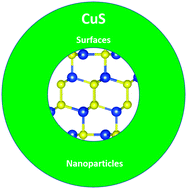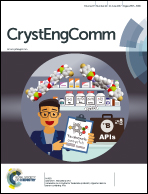Surfaces and morphologies of covellite (CuS) nanoparticles by means of ab initio atomistic thermodynamics†
Abstract
The promising application of CuS (covellite) nanoparticles in the biomedical field has motivated the present work with the aim of studying the stability of stoichiometric CuS surfaces and nanoparticles (NPs) under different conditions of pressure (p), temperature (T), and sulfur chemical potential (μS) by computational techniques using the density functional theory (DFT) formalism. Using the ab initio atomistic thermodynamic approach, the stability of several CuS surfaces is investigated by means of the linear relationship between surface energy γ and μS. A mixed surface labeled (001)-Cu/S has emerged as the most stable in all chemical potential ranges, whereas the surfaces with rich sulfur terminations labeled (020)-S, (100)-S, and (001)-S-2 are stable depending on the thermodynamic conditions. Additionally, we also investigate the composition and shape of CuS NPs as a function of μS using the Wulff construction method. These NPs show cylindrical and hexagonal prism shapes with top and bottom surfaces formed by (001)-Cu/S facets and the other surfaces are constituted by other facets depending on μS. Our description of the NPs, consistent with the reported experimental evidence, contributes significantly to the knowledge of CuS surfaces of the nanoparticle facets.



 Please wait while we load your content...
Please wait while we load your content...